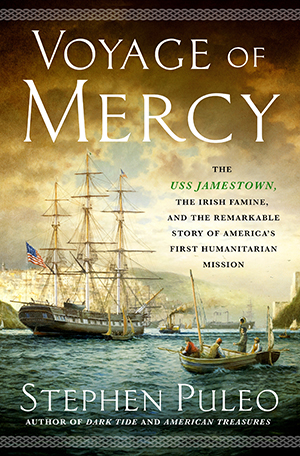VOYAGE OF MERCY: the USS Jamestown, the Irish Famine, and the remarkable story of America’s first humanitarian mission
Published in Book Reviews, Book Reviews, Issue 3 (May/June 2020), Reviews, Volume 28STEPHEN PULEO
St Martin’s Press
$28.99
ISBN 9781250200471
Reviewed by Dean Jobb
Dean Jobb is the author of Empire of deception and teaches non-fiction writing at the University of King’s College in Halifax, Nova Scotia.
 It was a perilous voyage—a run from Boston to Ireland in April, perhaps the stormiest month to be crossing the North Atlantic—and Rose Forbes was worried. Her husband was in command of a warship hastily requisitioned to carry relief supplies to desperate victims of the Great Famine. But a family friend urged her to look at the bigger picture. Robert Bennet Forbes’s daring mission had galvanised America and was a symbol of the ‘warm benevolence running, like an electric shock, through the whole land’.
It was a perilous voyage—a run from Boston to Ireland in April, perhaps the stormiest month to be crossing the North Atlantic—and Rose Forbes was worried. Her husband was in command of a warship hastily requisitioned to carry relief supplies to desperate victims of the Great Famine. But a family friend urged her to look at the bigger picture. Robert Bennet Forbes’s daring mission had galvanised America and was a symbol of the ‘warm benevolence running, like an electric shock, through the whole land’.
In Voyage of mercy, American journalist-turned-historian Stephen Puleo recreates Forbes’s humanitarian effort in riveting detail and uses the USS Jamestown’s delivery of food to Cork in 1847 as a springboard to explore how America’s response to the Famine transformed attitudes and international relations. ‘This is a story about hope, generosity, and soaring goodwill against a backdrop of nearly unfathomable despair’, he writes. ‘It was as though Americans looked at their own children and felt the pain of Irish parents who were watching their youngsters starve.’
Puleo, who married into an Irish-American family with roots reaching back to the forced migrations of the Famine years, weaves his narrative around the lives of two key players. Forbes was a Boston shipowner and Far East trader who had built, lost and regained a fortune by the time he was 40. When news of the scale of the Irish tragedy reached Boston at the beginning of 1847, he felt compelled to act. The other larger-than-life figure in Voyage of mercy is Revd Theobald Mathew of Cork, whose role in persuading thousands of Irishmen to swear off drink, Puleo contends, has overshadowed his work ‘in the trenches during the worst of the famine’.
Mathew was among the first to sound the alarm about the starvation and death in his midst and he pleaded with the British government to send aid. ‘No understanding can conceive, no tongue can express, the misery that prevails’, he warned Charles Trevelyan, the British treasury official who infamously attributed Ireland’s plight not to the failure of the potato crop but to an Old Testament-style retribution for ‘the moral evil of the selfish, perverse, and turbulent character of the people’.
Britain’s refusal to intervene was matched by political gridlock within the United States government. A belief that it would be unconstitutional to spend public funds on foreign aid stalled legislation that would have authorised relief. President James Polk, though wary of alienating Irish-American voters, was set to veto any aid bill that might have emerged from Congress. Sending supplies collected from individual donors in a naval vessel was a compromise that ended the impasse and set the stage for more than a hundred relief shipments from America that year.
Puleo is blessed with a hero who possessed a storyteller’s flair and eye for detail. Forbes, in his log of the Jamestown’s crossing to Ireland, described nights ‘black as Erebus’ (the passage to the underworld in Greek mythology), ropes frozen ‘stiff as crowbars’, the ship ‘bounding like an antelope’ in stormy seas. The captain was just as eloquent when he pondered the implications for future relief missions and British policy toward Ireland. ‘What we are doing will be an example to be followed by some abroad who might shut their hearts to the calls of their neighbors’, he told the Boston Post before setting sail. ‘It will prove a seed sown in fruitful ground.’
Mathew, too, emerges as a flesh-and-blood character who worked tirelessly to help famine victims. And, as Puleo’s luck would have it, his protagonists met when the Jamestown docked at Cork to unload 8,000 barrels of food. Mathew and Forbes toured some of the most desperate and hard-hit areas of the city, leaving the American in shock. ‘I would gladly forget, if I could, the scenes I witnessed’, he later confessed. ‘Hovels crowded with the sick and dying’, streets ‘filled with pale, careworn creatures’, emaciated ‘spectres’ waiting in line for a bowl of soup so foul he was certain it would have been ‘refused by well-bred pigs in America’.
The Jamestown mission and American aid to Ireland in the 1840s is a story that has been told before, including in History Ireland (‘“Charity begins at home”: the United States government and Irish Famine relief 1845–1849’, Summer 1996). But this is a largely forgotten tale for his main audience in the US and it will be an eye-opening, infuriating and uplifting read, especially for American descendants of the Irish diaspora.
America’s aid, Puleo argues, did more than forge closer ties between Ireland and the US; the precedent it established became a blueprint for foreign relief initiatives that followed. ‘Never before’, he notes, ‘had the people of one nation offered assistance to those of another on such a grand scale.’ Ultimately, however, this is the story of two selfless, determined men who lived worlds apart but joined forces to battle a common enemy—inaction. Voyage of mercy offers an inspiring and timely reminder that individuals have the power to make a difference.
















